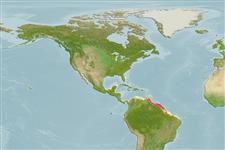Klassifizierung / Names
Namen | Synonyme | Catalog of Fishes(Gattung, Arten) | ITIS | CoL | WoRMS | Cloffa
Elasmobranchii (Haie und Rochen) (sharks and rays) >
Myliobatiformes (Stingrays) >
Dasyatidae (Stingrays) > Urogymninae
Etymology:
Environment: milieu / climate zone / depth range / distribution range
Ökologie
seewasser; brackwasser demersal; tiefenbereich 5 - 80 m (Ref. 114953), usually 5 - 25 m (Ref. 5217). Tropical
Western Central Atlantic: patchy distribution, from Belize to northern Brazil.
Size / Gewicht / Alter
Maturity: Lm ? range ? - ? cm
Max length : 150 cm WD Männchen/unbestimmt; (Ref. 5217); common length : 70.0 cm WD Männchen/unbestimmt; (Ref. 5217)
Kurzbeschreibung
Morphologie | Morphometrie
Disc is narrowly projecting to snout, pelvic fins with long anterior margins. Narrowly pointed falcate outer corners. Upper surface dark brown, lower surface pale with darker margins and teeth as yellowish white (Ref. 6902).
Found in shallow waters on sandy bottoms generally between 5 and 25 m depth. Reported from a depth of 810 m (Ref. 13608). Ovoviviparous (Ref. 50449).
Life cycle and mating behavior
Geschlechtsreife | Fortpflanzung | Ablaichen | Eier | Fecundity | Larven
Exhibit ovoviparity (aplacental viviparity), with embryos feeding initially on yolk, then receiving additional nourishment from the mother by indirect absorption of uterine fluid enriched with mucus, fat or protein through specialised structures (Ref. 50449). Distinct pairing with embrace (Ref. 205).
Cervigón, F., R. Cipriani, W. Fischer, L. Garibaldi, M. Hendrickx, A.J. Lemus, R. Márquez, J.M. Poutiers, G. Robaina and B. Rodriguez, 1992. Fichas FAO de identificación de especies para los fines de la pesca. Guía de campo de las especies comerciales marinas y de aquas salobres de la costa septentrional de Sur América. FAO, Rome. 513 p. Preparado con el financiamento de la Comisión de Comunidades Europeas y de NORAD. (Ref. 5217)
IUCN Rote Liste Status (Ref. 130435)
Bedrohung für Menschen
Venomous
Nutzung durch Menschen
Fischereien: weniger kommerziell
Mehr Information
Alter/GrößeWachstumLänge-GewichtLänge-LängeLängenhäufigkeitenMorphometrieMorphologieLarvenLarven Pop.Dyn.RekrutierungDichteBRUVS
ReferenzenAquakulturAquakultur ProfilZuchtlinienGenetikElectrophoresesVererbbarkeitKrankheitenVerarbeitungNutrientsMass conversion
Tools
Warning: mysqli::__construct(): (HY000/1040): Too many connections in /var/www/html/includes/speciessummary.lib.php on line 2414
Can't connect to MySQL database fbquizv2. Errorcode: Too many connections
